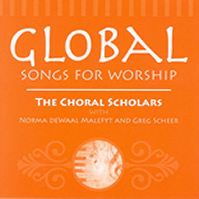It seems that a truce has been called in the so-called worship wars. Or at least I seem to hear a lot less these days about worship wars raging in the church.
Perhaps this lull in the fighting is because the church in the West has finally realized it has bigger problems to address than whether we go traditional or contemporary in our musical worship. Or perhaps (a less promising possibility!) the silence on these questions reflects the fact that each has decided to go his or her own way – the contemporary worshippers and the traditional worshippers have simply parted company, so there’s nothing left to fight over.
Whatever the case case, I’m not intending to open a new front in these old battles. There is one suggestion I would like to make, however, no matter where we have finally settled on the question of our worship style. My simple suggestion is that we remain open and attentive to the worship styles and content that come to us from the global church.
In fact, the Church Doctrine Committee, in its report to the General Assembly for 2015, offers the following (among many other things) in its offer of a missional theology:
14.6 The church should be in touch with, and share in, the music of global Christianity – so that it can learn from and be shaped by the gospel’s enculturation in other contexts.
This isn’t to say that such attention is utterly lacking in our congregations. Some local churches are more than aware of the ways that our worship can be enriched by the melodies and rhythms and themes of global Christianity. But I also know of plenty of worshipping communities (blended, contemporary, traditional) where the diversity of the worldwide church never finds expression in music.
 When it comes to introducing such music within the life of the church, there are a variety resources available – resources that can helpfully and gently move a congregation beyond the narrow confines of western music. One such resource that has enriched the worship within my own congregation is a little songbook of worship music published by Faith Alive Resources, entitled Global Songs for Worship. (Click the image for more information…) Let me describe just a couple of pieces that are included in this collection.
When it comes to introducing such music within the life of the church, there are a variety resources available – resources that can helpfully and gently move a congregation beyond the narrow confines of western music. One such resource that has enriched the worship within my own congregation is a little songbook of worship music published by Faith Alive Resources, entitled Global Songs for Worship. (Click the image for more information…) Let me describe just a couple of pieces that are included in this collection.
One particularly lovely piece (to me, at least!) is entitled Send your Word, O Lord (translated from the Japanese song Mikotoba o kudasai), a song which, in both its melody and imagery, expresses certain elements of Japanese culture. I should add that this piece is particularly appropriate at Kensington since we have a number of Japanese-Canadian families within the congregation. The first verse:
Send your Word, O Love, like the rain, falling down upon all the earth. Send your Word. We seek your endless grace, with souls that hunger and thirst, sorrowfully agonize. We would all be lost in dark if without your guiding light.
Another from the Russian evangelical tradition similarly expresses something of Russian culture and of evangelical faith in both its melodic and lyric content (All Along):
Long I wandered in the darkness, on the paths of death and sin. With this life, so disappointed, from this world, deceived within. “Then I cried out who can help me? Who can save me from this woe?” Then I heard the Saviour’s voice say, “How I’ve loved you all along.”
Refrain: “All along, all along, how I’ve loved you all along. Long before you ever sought me, yes I’ve loved you all along.”
In its own right, such music is a tremendous gift to any worshipping community. It is a reminder that the good news of Jesus Christ comes to expression in distinct ways across the globe – which reflects, of course, the truth of the incarnation, by which the Word becomes flesh in a particular time and place. This music also comes to us as a source of enrichment or challenge or even correction within the particular cultural manifestation of our own Christian faith. It makes us consider what we might have missed or neglected in our own life of faith in Christ and with others.
Whenever we sing one of these songs at Kensington there is, above all perhaps, some small reminder that the church is a wide and beautiful community of those who live in relation to the risen Jesus. Worship is not simply us in our own building, or our own city, or our own country – our voices are joined with those of others across time and space.
And then I should perhaps add that, at a very pragmatic level, the gift of such music is that
- it can help open a traditional congregation to alternative styles, and perhaps lead the way to a more blended approach to worship,
- it fits well within a contemporary worship style, and
- it can serve as a bridge between contemporary and traditional western music in a blended worship framework.
But above all, to explore and embrace such music is simply to acknowledge the truth of Christ’s Body – rich and diverse and beautiful. In the end there is really no need to make up excuses for embracing this reality.
